

3D model of a nerve terminal in atomic detail. The electrochemical jelly inside your head contains something like one quadrillion synapses, the junctions at which nerve cells talk to one other by converting electrical signals into chemical ones and then back again.
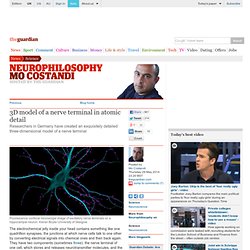
They have two components (sometimes three): the nerve terminal of one cell, which stores and releases neurotransmitter molecules, and the 'post-synaptic' membrane of another cell, which contains binding sites for the neurotransmitters. Massive Brain Map Should Include Star Cells, Study Says. The science behind disgust - Neuroscience. We all have things that disgust us irrationally, whether it be cockroaches or chitterlings or cotton balls.

For me, it’s fruit soda. It started when I was 3; my mom offered me a can of Sunkist after inner ear surgery. Still woozy from the anesthesia, I gulped it down, and by the time we made it to the cashier, all of it managed to come back up. The neuroscience of happiness. They say money can’t buy happiness. But can a better understanding of your brain? As recent breakthroughs in cognitive science break new ground in the study of consciousness — and its relationship to the physical body — the mysteries of the mind are rapidly becoming less mysterious. But does this mean we’ll soon be able to locate a formula for good cheer?
The Neuroscience of Looking on the Bright Side. Ask a bride before walking down the aisle “How likely are you to get divorced?”

And most will respond “Not a chance!” Tell her that the average divorce rate is close to 50 percent, and ask again. Would she change her mind? Unlikely. Even law students who have learned everything about the legal aspects of divorce, including its likelihood, state that their own chances of getting divorced are basically nil. The Age Of Insight. Eric Kandel is a titan of modern neuroscience.
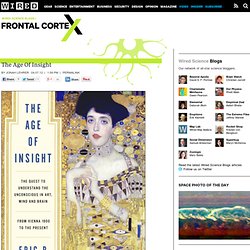
He won the Nobel Prize in 2000 not simply for discovering a new set of scientific facts (although he has discovered plenty of those), but for pioneering a new scientific approach. As he recounts in his memoir In Search of Memory, Kandel demonstrated that reductionist techniques could be applied to the brain, so that even something as mysterious as memory might be studied in sea slugs, as a function of kinase enzymes and synaptic proteins. Brain Scan Foretells Who Will Fold Under Pressure. Everyday Stress Can Shut Down the Brain's Chief Command Center. The entrance exam to medical school consists of a five-hour fusillade of hundreds of questions that, even with the best preparation, often leaves the test taker discombobulated and anxious.

For some would-be physicians, the relentless pressure causes their reasoning abilities to slow and even shut down entirely. The experience—known variously as choking, brain freeze, nerves, jitters, folding, blanking out, the yips or a dozen other descriptive terms—is all too familiar to virtually anyone who has flubbed a speech, bumped up against writer’s block or struggled through a lengthy exam. Personality Traits Correlate With Brain Activity. Your personality says a lot about you.
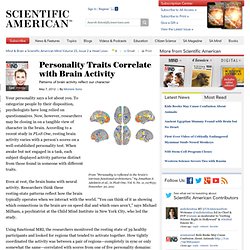
To categorize people by their disposition, psychologists have long relied on questionnaires. Now, however, researchers may be closing in on a tangible view of character in the brain. According to a recent study in PLoS One, resting brain activity varies with a person’s scores on a well-established personality test. When awake but not engaged in a task, each subject displayed activity patterns distinct from those found in someone with different traits.
Even at rest, the brain hums with neural activity. Using functional MRI, the researchers monitored the resting state of 39 healthy participants and looked for regions that tended to activate together. Gold nanoparticles boost accuracy of brain surgery - health - 17 April 2012. When surgeons tackle a tumour in the body, they can usually afford to remove potentially healthy tissue from around the cancerous mass to make sure they get rid of every harmful cell.

In the brain they don't have this luxury – healthy cells are too important to lose. Gold nanoparticles may now give surgeons the clearest view yet of cancerous cells during an operation, helping them to remove tumour cells without harming their healthy neighbours. Surgeons regularly use magnetic resonance imaging to guide brain surgery. However, some cancerous cells – unseen by MRI or the naked eye – can be left behind.
To overcome this problem, Sanjiv Gambhir at Stanford University in California and colleagues have developed spherical nanoparticles with properties that help surgeons detect cancerous cells in three different ways. Blood-brain barrier. Science's Long—and Successful—Search for Where Memory Lives. During that visit, the three sat down to see if they could figure out the discrepancy in the data.

The “problem,” Silva felt, might in fact be an opportunity: a hint of how they could use CREB as a tool not merely to enhance or suppress memories but to explore each new memory’s precise location—to locate the engram. Maybe after all these years, it would be possible to find true tracks of memory in the brain. Perhaps it was actually necessary for only a small percentage of neurons to be involved in forming a memory.
How mapping neurons could reveal how experiences affect mental wiring. This article was taken from the July 2012 issue of Wired magazine.
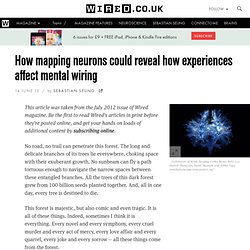
Be the first to read Wired's articles in print before they're posted online, and get your hands on loads of additional content by subscribing online. No road, no trail can penetrate this forest. The long and delicate branches of its trees lie everywhere, choking space with their exuberant growth. No sunbeam can fly a path tortuous enough to navigate the narrow spaces between these entangled branches. Neuroscience: The mind reader. Adrian Owen still gets animated when he talks about patient 23.
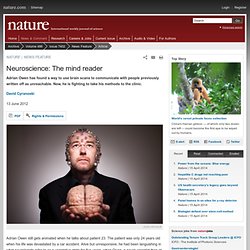
The patient was only 24 years old when his life was devastated by a car accident. Alive but unresponsive, he had been languishing in what neurologists refer to as a vegetative state for five years, when Owen, a neuro-scientist then at the University of Cambridge, UK, and his colleagues at the University of Liège in Belgium, put him into a functional magnetic resonance imaging (fMRI) machine and started asking him questions. Incredibly, he provided answers. The Neuroscience of Barbie. In science fiction and fantasy tales, there is a long running fascination with the idea of dramatically diminishing or growing in stature. In the 1989 classic, Honey, I Shrunk the Kids, Rick Moranis invents a device which accidentally shrinks both his own and the neighbor’s children down to a quarter-of-an-inch tall. Preceding this by more than 100 years, Lewis Carroll wrote about a little girl who, after tumbling down a rabbit hole, nibbles on some cake and then grows to massive proportions.
Nearly 300 years ago, Jonathan Swift described the adventures of Gulliver while on the island of Lilliputan, on which he is a giant, and then on the island of Brobdingnag, where everyone else is a giant. These kinds of experiences, however, have been limited to the world of fictional stories. The world around us does not actually change in size. Or at least, they were mythical until recently. Adventures In Behavioral Neurology—or—what Neurology Can Tell Us About Human Nature. When you look at the structure of the brain it's made up of neurons. Of course, everybody knows that these days. There are 100 billion of these nerve cells. Each of these cells makes about 1,000 to 10,000 contacts with other neurons. From this information people have calculated that the number of possible brain states, of permutations and combinations of brain activity, exceeds the number of elementary particles in the universe.
The question is how do you go about studying this organ? Behavioral neurology has a long history going back about 150 years, a venerable tradition going back to Charcot. It doesn't have to be a lesion; it can be a genetic change. Out-of-body experience: Master of illusion. N. Larsson/AP for Nature It is not every day that you are separated from your body and then stabbed in the chest with a kitchen knife.
But such experiences are routine in the lab of Henrik Ehrsson, a neuroscientist at the Karolinska Institute in Stockholm, who uses illusions to probe, stretch and displace people's sense of self. Today, using little more than a video camera, goggles and two sticks, he has convinced me that I am floating a few metres behind my own body. As I see a knife plunging towards my virtual chest, I flinch. Podcast interview with Ed Yong. Current Biology - Selective Attention in an Insect Visual Neuron.
To view the full text, please login as a subscribed user or purchase a subscription. Click here to view the full text on ScienceDirect. Figure 1 Receptive Fields of CSTMD1 in Hemicordulia tau and Response to Moving Targets. BrainFacts.org Homepage. Neuroskeptic. Forget the hype: how close are we to a ‘forgetting pill’? The Scicurious Brain: The Good, Bad, and Weird in Physiology and Neuroscience. Problems in the neurozone - Counterbalanced Blog. Unhurtful Thoughts: A Preoccupied Brain Produces Pain-Killing Compounds.
Thinking of something else is a time-honored method for coping with pain. Indeed, psychologists have demonstrated repeatedly that what you think about can modulate the pain you experience. Neuroscience Coverage: Media Distorts, Bloggers Rule. High fat diets and depression: a look in mice. Only a few weeks ago I looked at a study on fast food consumption and depression, and only a few days ago I talked about a brand new study looking at high fat diets and protection from heart attack damage. And today, we’ve got another study on high fat diet, this time in mice, and depressive-like behavior.
Spurious Positive Mapping of the Brain? German Scientists Tap NVIDIA GPUs to Unlock Secrets of the Brain - MarketWatch - Pentadactyl. Are We “Meant” to Have Language and Music? Discover Interview: The Radical Linguist Noam Chomsky. For centuries experts held that every language is unique. The Secret Language Code. The Neuroscience of Your Brain On Fiction. Music: It's in your head, changing your brain. Kiki or bouba? In search of language's missing link - life - 18 July 2011. How Physics and Neuroscience Dictate Your "Free" Will. The mismeasure of neuroscience. Brain drain. Why The Future of Neuroscience Will Be Emotionless.
Decoding the Body Watcher. The Trust Molecule by Paul J. Zak. Why Emotions Are Attention-getters. Cooperative Neural Networks Suggest How Intelligence Evolved. Memory Foraging: When the Brain Behaves Like a Bee. Human brain organised like a 3D 'New York City' grid - health - 29 March 2012. The Brain's Highways: Mapping the Last Frontier.
Neuroscience. Visions For All. Do Psychedelics Expand the Mind by Reducing Brain Activity? Neurons handle sensory data in order. How Neuroscientists and Magicians Are Conjuring Brain Insights. Best evidence yet that a single gene can affect IQ - health - 16 April 2012. New genes linked to brain size, intelligence. A Neuroscientist's Quest to Reverse Engineer the Human Brain. The Brain: The Connections May Be the Key. MIT discovers the location of memories: Individual neurons. Consciousness Does Not Reside Here. Know Your Neurons: The Discovery and Naming of the Neuron. Know Your Neurons: How to Classify Different Types of Neurons in the Brain’s Forest.